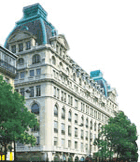PARISIAN QUARTERS
LE QUARTIER DE LA BASTILLE

Source: www.parisbalades.com
Of course, you shouldn’t visit this quarter and miss the OpĂ©ra Bastille for more information, follow this link (OpĂ©ra de Paris). One of the “grand works” of François Mitterand, the opera house was finished in 1989 and adorns this revolutionary square in the east of Paris, helping to rebalance the focus of the city in that direction.
LE QUARTIER DE LA DEFENSE

Source: www.parisbalades.com
The 130 hectare area is nowadays home to the headquarters of various French industrial and financial groups, as well as the overseas offices of various large multinationals. Beneath the central paved square, bordered by the CNIT centre and the Grande Arche, is one of the largest shopping centres in Europe.
LE QUARTIER LES GRANDS BOULEVARDS

Source:
www.parisbalades.com
(Metro Boulevards des Italiens, Montmartre, Poissonnière,
Strasbourg Saint Denis, Les Grands Boulevards, Saint-Martin, between
the 2nd, 8th and 9th arrondissements)
After the victories of 1670, when the defence
of Paris was judged to have shifted to the national borders, Louis
XIV decided to replace the city walls established by Charles V
and Louis XIII with a planted pathway (the victories of Louis
XIV are commemorated by two arcs de triomphe at the Porte Saint-Martin
and the Porte Saint-Denis).
The boulevards then became a place for pleasant walks for Parisians,
they attended vaudeville theatre there, as well as the cafés
and the great statue-decorated hotels, the covered passageways,
then later the first cinemas (the Grand Rex, the Max Linder Panorama). Due to its proximity
to the stock exchange, the large banks built financial “cathedrals”
there in the late 1800’s. This is especially noticeable
on Boulevard des Italiens (which got its name because it was once
home to the theatres of the Comédie Italienne, since become
the Opéra-Comique).
To the north of Grands boulevards
Very close to the Grand Rex cinema, you will come across ACCORD LANGUES, a languages school that welcomes children and adults who wish to learn the French language.
ACCORD LANGUES is a school of languages in co-ordination with the Universities of Paris V, Paris VII and Paris VIII
14 boulevard Poissonnière / 75009 Paris / France
TĂ©l : 33 (0) 1 55 33 52 33 / Fax : 33 (0) 1 55 33 52 34
e-mail : info@french-paris.com
/ e-mail : info@accord-langues.com
Click below to consult the websites of the Accord School of Languages:
-SCHOOL
OF FRENCH LANGUAGE
-STUDY
FRENCH IN PARIS
-LEARN
FRENCH WHILE HAVING FUN!
-TEACHING
FRENCH AS A FOREIGN LANGUAGE
-LEARN
FRENCH IN FRANCE
Several accommodation options (youth hostels…) are made available through association with Accord School of Languages.
LE QUARTIER DE LA VILLETTE

Source: www.parisbalades.com
A commune on the outskirts of Paris, La Villette was annexed by the capital in 1860. The area became home to the city’s abattoirs, constructed there in 1867. In 1976 a competition was launched to find a new use for the area and the Cité des Sciences came about as a result. In 1983, Bernard Tschumi was named the civil engineer in charge of this vast 50 hectare area.

Source: www.parisbalades.com
LE QUARTIER DE BARBES ET DE LA GOUTTE D'OR

Source: www.parisbalades.com
LE QUARTIER DE SAINT-GERMAIN-DES-PRES

© Pariserve.com
Originally the abbey of St Germain was surrounded by nothing but fields, cultivated by the Bendictine monks. Within the church are the tombs of the Merovingians, who were inhumed by Saint Germain himself, the bishop of Paris. Reconstruction of the current church began in 990 following the destruction of the original during the Norman invasions. The abbey gave part of its grounds along the banks of the Seine to the university, which took the name Pré-aux-Clercs. After the revolution the quarter was abandoned and only came back into fashion after the Second World War. It renewed its intellectual tradition as its cellars were frequented by such famous figures as Vian, Sartre and Simone de Beauvoir.
The famous quarters are what make up the renown of Paris and are certainly worth exploring. To find out more, we recommend that you follow this link: a walk in Paris.
- Paris-city Partners :
- Music News
- Rock, Jazz & Blues CDs
- Learn French in Paris
- Learn French in France
- Paris Junior Programs
- Learn English in England
- Business English Courses
- Need a translation?
- For teachers of French
- French Exercise & Tests
- Directories
- English courses for Teens in UK
- Camps for Teens in England
- Language Courses Abroad
- English courses in England
- Learn a Language Abroad


